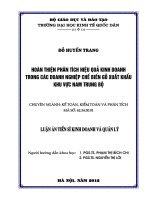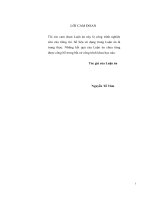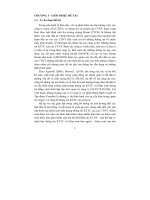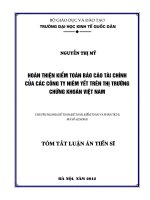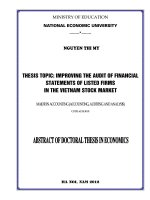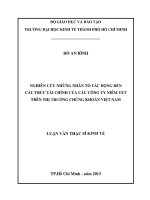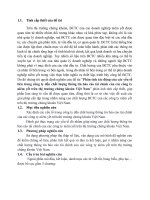Luận án : Hoàn thiện tổ chức kiểm soát nhằm tăng cường chất lượng thông tin kế toán tài chính của các công ty niêm yết trên thị trường chứng khoán việt nam
Bạn đang xem bản rút gọn của tài liệu. Xem và tải ngay bản đầy đủ của tài liệu tại đây (1.29 MB, 135 trang )
0
MANAGEMENT OF THE FACULTY TEACHING ACTIVITIES IN THE ART
SCHOOLS IN NORTH VIETNAM: A PROPOSED
ENHANCEMENT PROGRAM
A Dissertation Presented to
the Faculty of the Graduate School
Southern Luzon State University, Lucban, Quezon, Philippines
In Collaboration with
Thai Nguyen University, Socialist Republic of Vietnam
In Partial Fulfillment of the
Requirements for the Degree of
Doctor of Philosophy in Educational Management
Nguyen Thi Yen Nga (Anna)
April, 2014
APPROVAL SHEET
In partial fulfillment of the requirements for the degree Doctor of Philosophy in
Educational Management Program, this research study entitled Management of the faculty
teaching activities in the art schools in NorthVietnam: A proposed enhancement
programhas been submitted by Nguyen Thi Yen Nga (Anna) and is here by recommended for oral
examination.
PROF. Dr. WALBERTO A. MACARAAN
Research Adviser
Approved by the Oral Examination Committee, in partial fulfillment of the
requirements for the degree Doctor of Philosophy in Educational Management Program offered
by Southern Luzon State University, Republic of the Philippines in collaboration with Thai
Nguyen University, Socialist Republic of Vietnam.
(NAME OF PROFESSOR)
Member
(NAME OF PROFESSOR)
Member.
(NAME OF PROFESSOR)
Chairman
Accepted in partial fulfillment of the requirements for the degree Doctor of Philosophy in
Educational Management Program offered by Southern Luzon State University, Republic of the
Philippines in collaboration with Thai Nguyen University, Socialist Republic of Vietnam.
APOLONIA AESPINOSA, Ph.D.
Dean, Graduate School
WALBERTO A. MACARAAN, Ed.D. Vice
President, Academic Aff airs
Date_____________________
2
ACKNOWLEDGMENT
Grateful acknowledgement is hereby extended to the following individuals who have
provided the researcher much needed help in the completion of this work:
DR. CECILIA N. GASCON, Ph.D., President of the Southern Luzon State University in
the Republic of the Philippines, for her untiring effort and belief that this collaboration is possible
thus enabling us to pursue the Ed.D degree;
Prof. Dr. DANG KIM VUI, President of ThaiNguyenUniversity, the Socialist Republic of
Vietnam for his incomparable contribution and support to the Doctor of Philosophy in Educational
Management program in Cooperation with the Southern Luzon State University, the
SocialistRepublic of the Philippines;
Dr. WALBERTO A. MACARAAN, Vice president, Academic Affairs for his support to
the tie – up program between SLSU and TNU and his adviser, for guidance and endless support
for the improvement of this study;
Dr. APOLONIA A. ESPINOSA, Dean, Graduate school for his support to the tie – up
program between SLSU and TNU;
Prof. Dr. TRAN VAN DIEN, Rector of Thai Nguyen University of Agriculture and
Forestry for his invaluable assistance in the establishment of the Doctor of Philosophy in
Educational Management program in cooperation with the Southern Luzon State University,
Philippines;
Dr. NGUYEN TUAN ANH, Former Director of the InternationalTrainingCenter,
ThaiNguyenUniversity for his precious and wholehearted assistance and encouragements in the
3
establishment of the Doctor of Philosophy in Educational Management program in cooperation
with the Southern Luzon State University, Philippines;
DR. NGUYEN THE HUNG, Ph.D., Director of the International Training Center, Thai
Nguyen University of the Socialist Republic of Vietnam, for his enormous pursuit to provide the
Vietnamese people an opportunity to grow through education;
Dr. RICARYL CATHERINE P. CRUZ for her adviser, dedication, enduring patience and
concern, guidance, sincere hopes and encouragement for the researcher to finish the manuscript;
Dr. TERESITA V. DE LA CRUZ and Dr. APOLONIA.A.ESPINOSA professors of
method of research and advanced statistics for their patience and support;
The visiting Professors including Dr.ARIVALAN, Dr. BALAKRISHNAN, Dr.
WALBERTO A. MACARAAN, Dr. LEE KAR LING, Dr. W.JOHNSON and other professors
for their lectures;
The Learning Resource Center of Thai Nguyen University, for the valuable sources of books
and references;
ITC STAFF, for providing the necessary research materials;
The authors and researchers of books and unpublished graduate theses and dissertations that
served as reliable source of data and information;
The college members of Thai Nguyen University, for the approval of the researcher’s
request to conduct the study;
The Management, teacher and students respondents, for their patience and generosity in
answering the questionnaire.
For all the teachers in the art schools in NorthVietnam whose passion for teaching makes
difference in the life of their learners;
4
My loving classmates and colleagues, for the endless support and friendship which inspire
the researcher to put his best in finishing the study;
Above all, My family from whom all good things come, who has continually given the
researcher everything she needs at the proper time: the enlightened patience and the determination to
go through the stages of this intellectual quest to achieve a desired end.
To you all, THANK YOU VERY MUCH!
NGUYEN THI YEN NGA (ANNA)
5
TABLE OF CONTENTS
TITLE PAGE ………………….……………………………………………………… ……… 1
ACKNOWLEDGMENT 2
TABLE OF CONTENTS 5
LIST OF TABLES 7
LIST OF APPENDICES Ошибка! Закладка не определена.
ABSTRACT 10
BACKGROUND OF THE STUDY 14
OBJECTIVES OF THE STUDY 16
HYPOTHESIS 17
SIGNIFICANCE OF THE STUDY 17
SCOPE AND LIMITATIONS OF THE STUDY 18
DEFINITION OF TERMS 18
Chapter II. REVIEW OF LITERATURE AND STUDIES 24
RELATED LITERATURE AND STUDIES 24
RESEARCH PARADIGM 37
Chapter III. METHODOLOGY 45
LOCALE OF THE STUDY 45
RESEARCH DESIGN 51
POPULATION AND SAMPLING 51
INSTRUMENTATION 54
DATA GATHERING PROCEDURE 54
STATISTICAL TREATMENT 55
CHAPTER IV. PRESENTATION, ANALYSIS AND INTERPRETATION OF DATA 59
Chapter V. SUMMARY, CONCLUSIONS, AND RECOMMENDATIONS 5
SUMMARY 5
6
CONCLUSIONS 6
RECOMMENDATIONS 7
BIBLIOGRAPHY 9
APPENDICES 11
APPENDICES A 12
COMMUNICATION LETTERS 12
APPENDICES B 17
QUESTIONAIRE ON THE MANAGEMENT OF THE FACULTY TEACHING ACTIVITIES
IN THE ART SCHOOLS IN NORTH VIETNAM: A PROPOSEDENHANCEMENT
PROGRAM 17
APPENDICES C 25
SCHEDULE OF COMPUTATIONS 25
7
LIST OF TABLES
Table 1.Frequency, Percentage and Distribution of the Respondents for Teachers and
Administrator 52
Table 2.Frequency, Percentage and Distribution of the Respondents for Students 53
Table 3. Weighted Mean of the Teaching Activities among Administrators and Teachers as to
Teaching Plan and Preparation 59
Table 4. Weighted Mean of the Teaching Activities among Administrators and Teachers as to
Management of the Program 62
Table 5. Weighted Mean of the Teaching Activities among Administrators and Teachers as to
Time Management 66
Table 6. Weighted Mean Average of the Teaching Activities among Students of the Art School as
to Professional Competencies on the Program 69
Table 7. Weighted Mean of the Teaching Activities among Students of Art Schools as to
Methods and Teaching Skills 73
Table 8. Weighted Mean of the Teaching Activities among Students of the Art Schools as to
Ensure Their Teaching and Relationships with Students 77
Table 9. Mean Difference among Teachers and Administrators of Respondent Schools as to
Teaching Plan and Preparation 79
Table 10. Mean Difference among Teachers and Administrators of Respondent Schools as to
Management of the Program 82
8
Table 11. Mean Difference among Teachers and Administrators of Respondent Schools as to
Teaching Time Management 84
Table 12. Mean Difference of Students of Respondent Schools as to Professional Competence of
Teachers 86
Table 13. Ascertain if there is significant difference students of Methods and teaching skills of
teachers 89
Table 14. Ascertain if there is significant Difference students of Ensure their teaching and
relationships with students 91
Table 15. Perceived Common Problems in the Management of Faculty teaching Activities 93
Table 16. Common Problem on the Management of Teachers by School 96
9
LIST OF FIGURES
Figure 1. The Schematic Presentation of the Independent and Dependent Variables of the Study
37
Figure 2. Location of Viet nam university fine arts 46
Figure 3. Location of Viet Bac College of art and culture 47
Figure 4. Vietnam Dance college 48
Figure 5. Location of Ha Noi university of culture 49
Figure 6. Location of Thanh Hoa University of Culture, Sports and Tourism 50
10
Title
: MANAGEMENT OF THE FACULTY TEACHING ACTIVITIES
IN THE ART SCHOOLS IN NORTH VIETNAM: A PROPOSED
ENHANCEMENT PROGRAM
Researcher
: NGUYEN THI YEN NGA (ANNA)
Degree
: Doctor of Philosophy in Educational Management Program
Name/ Address of
the Institution
: Southern Luzon State University, Lucban, Quezon, Philippines in
Collaboration with Thai Nguyen University, Socialist Republic of
Vietnam.
Date Completed
: April, 2014.
Adviser
: PROF. Dr. WALBERTO A. MACARAAN
ABSTRACT
The main purpose of this was the evaluation of faculty teaching activities to improve
the quality training of art school in Vietnam with a view to the development of quality training
schools of art in Vietnam in the period 2013 – 2020.
The dissertation assessed the teaching activities of teachers in art schools from the point
of views of managers and teachers in terms of teaching plan and preparation, management of the
program and teaching time management based on standards: talent development, assessment
tools, action programs, learning objectives, learning outcomes, reasonable allocation,
competences and skills of teachers, and the overarching monitoring classes, according to the
11
evaluation criteria of the Ministry of Education and Training in order to enhance teachers’
teaching competencies in art schools.
This study used the descriptive correlation design in analyzing the investigated
variables. The dissertation evaluated the teaching activities of teachers in art schools from the
point of views of students in terms of professional competencies, methods and teaching skills,
peers and student relations through activities: providing necessary documents to prepare for the
course, lesson presentation; combination of teaching methods, developing talent and artistic
potential.
The questionnaire was used as major data-gathering instrument and unstructured
interview was done to cross check the responses of the respondents. There were 325 teachers,
administrator and students used as respondents in this study. Weighted mean and chi-square
regressions were used in the study to analyze the data.
The respondents ranked the instructional variables that influence the performance of
selected sectarian schools as follows: There is no significant difference between administrators
and faculty about teaching plan, management of the program and teaching time management. But
there is significant difference in the lesson presentation of the teachers, the use of textbooks and
reference materials, contents of the course, lesson objectives, lesson sequences in accordance
with the knowledge and skills of students.
Inasmuch as the Educational managers can also use methodology, instrument and
questionnaire of the research to evaluate building program, management of the program and
teaching time management according to specific rules of teachers teaching art. From the results of
research, educational managers plan to evaluate teachers scientifically and accurately in the art
schools in the whole country.
12
Chapter 1. INTRODUCTION
In the globalization and economic integration in Vietnam, the use of human resources
becomes a challenge for the mankind. The quality is always the first concern of the society
because it is the human’s motivation to continually rise and develop. Stepping into the 21st
century the Vietnamese education has undergone 15 years of renovation and has achieved
important results such as increased enrollment, diversification of delivery modes and improved
school infrastructure. The level of mass education has been increased. The quality of education
began changing positively. In the trends in integration, development and competitiveness,
ensuring and improving the quality of education is the task of schools. Therefore, schools are
interested in investing for management of the quality of the school. Competency-based
assessment is the current quality-driven approach to trainings and development of human
resources.
Faculties and teaching staff have special role in the education, are determinant factor
for the quality and efficiency of education. Teaching process has been seen as the mean for
learning quality management. Conducting all steps in teaching process means lecturers of school
have participated in managing teaching quality for them and for the institutions.
There would be no good education without good faculty quality, teaching effectiveness
is the core mission of schools. Students are the subjects of teaching activities, but the key factor
of teaching effects is faculty because education quality is influenced by teaching effect.
Evaluation of faculty’ teaching activity is the key to probe into faculty quality to help faculty
ascertain their shortcomings so that they can not only improve themselves but also increase their
teaching effectiveness.
13
Effective teaching is activity which promotes the intellectual vitality of the university
and the wider community. The primary focus of this activity is transmission of knowledge and
the development of new skills, insights, and sensitivities within the classroom; teaching is not
limited to that setting. It also includes the advising, supervising and mentoring of students, the
sharing of personal and professional growth with others, and the presentation of intellectual and
moral concerns within the university community.
Resolution No.14/2005/NQ-CP dated November 2, 2005 by Government of Vietnam on
Substantial and comprehensive renewal of Vietnam's tertiary education in the 2006-2020 period
affirmed: ―To build up a sufficient contingent of tertiary education lectures and administrators,
who have ethical quality and professional conscience, high professional qualifications and an
advanced teaching and management style‖. Student evaluation of teaching has been a compulsory
practice of institutional quality evaluation since the academic year 2009-2010. Because there are
aspects of teaching performance that cannot be evaluated only by students most schools regard
student evaluations of teaching as one source of information for improving effectiveness of
teaching. Faculty assessment has been tested in a number of training institutions in the form of
tested; the assessment results are used to improve the teaching quality of faculty.
Many Vietnamese scientists have studied this issue, such as the research: Master Pham
XuanThanh, Quality of Postgraduate Training in Vietnam: Definition, Criteria and Mesurement
scales; Nguyen Phuong Nga (2007): "Student faculty evaluations - testing and modeling tools"
National University Publishing House Hanoi;… In 2000, the Ministry of Education and Training
Vietnam funded a project to develop a common set of questionnaires to evaluate the quality of
teaching and the scientific research ability. This set includes:
(1) Course Evaluation Form (for students);
14
(2) Evaluation of Teaching and Research Activities (for individual faculty) or Self-
Assessment;
(3) Evaluation of Teaching and Research Activities (for collegiate assessment) or Peer-
Assessment; and
(4) Class Observation. Major parts in the evaluation are ten items which ask the
students to evaluate a particular teaching behavior.
In general, these studies are macro without deep research on evaluation of faculty
teaching activities, especially in art schools in Vietnam. Therefore, improving the quality of
teaching is background to improve the quality training in art schools is necessary now; this study
makes this research even more imperative in Vietnam now.
BACKGROUND OF THE STUDY
Faculty assessment activities have a long time, a number of progress education were
interested in evaluating faculty. Middle Ages of Europe, faculty assessment activities developed,
the United States has many popular activities on faculty evaluations at multiple institutions.
Sources of faculty evaluations include: colleagues, Observation, Client feedback,
students, managers, employers, classroom visits, teaching dossier and self-evaluation of each
faculty. Evaluation of other sources including student test results, daily diaries, tapes, tape record
the work of faculty or teaching dossier, to the assessment of faculty effectiveness, need to from
many different sources.
The evidence provided by different evaluation resources to help improve the accuracy
of evaluation. Power supply has its own characteristics, but will not be suitable if used for
different purposes. Although, self-evaluations is subjective but self-evaluation is very important
in the evaluation of faculty and it's necessary to do. The evaluation of the quality of teaching can
15
be done with different tools. It is possible that the survey questionnaire, interview questions,
observation sheets
Traditional arts are part of the cultural heritage of a group of people whose members
share a common ethnic heritage, language, religion, occupation, or geographic region. These
artistic traditions are passed down through generations and reflect the values of their shared
culture. Skills are typically learned directly through observation and imitation from someone
steeped in the tradition, rather than through classes, books, or other means of institutional
instruction.
Art faculty are qualified educators and, in some instances, artists that instruct students
in theoretical and practical knowledge in art theory, art history, aesthetics, visual art, ceramics,
design and other art-related subjects.
Evaluation of teaching in art schools there are some differences: the teaching and
learning environment characteristics, the level of awareness, gender, ethnicity, therefore
evaluate teaching in art schools have constraints but the evaluation of teaching is an inevitable
trend, which is a mandatory, teaching art schools need comprehensive preparation of theory and
practice to ensure improved training.
In order to effectively improve teaching quality, art schools has put a lot of continuous
effort into studies related to facultys’ teaching effectiveness. However, there is no complete
system in Vietnam which can be used as a tool to evaluate faculty’ teaching to improve the
quality training of art school.
Based on this background, the researcher intends to find other processed to evaluation
of faculty teaching activities to improve the quality training of art school in Vietnam.
16
OBJECTIVES OF THE STUDY
The main purpose of this was the evaluation of faculty teaching activities to improve
the quality training of art school in Vietnam with a view to the development of quality training
schools of art in Vietnam in the period 2013 – 2020.
Specifically it aimed to answer the following:
1. Assess the teaching activities of teachers from the point of views of respondents in
terms of:
1.1 Teaching Plan and Preparation
1.2. Management of the Program
1.3. Teaching time management
2. Assess the teaching activities of the teachers from the point of views of student
respondents in terms of:
2.1. Professional Competencies on the Program
2.2. Methods and Teaching Skills of Teachers
2.3. Peers and Student Relations
2.4. Learning outcome assessment test
3. Ascertain if there is significant difference among the two group of respondents
(Teachers and Administrators)
4. Ascertain if there is significant difference among the students perception of the 5
respondent schools
5. Find out the problems encountered in the management of teaching activities among
17
5.1. Teachers
5.2. Administrator
5.3. Students
6. Develop an enhancement program
HYPOTHESIS
1. There is no significant difference in the point of views of the two group of
respondents as to teaching activities of teachers.
2. There is no significant difference among students of the 5 respondent schools.
SIGNIFICANCE OF THE STUDY
This study attempting of evaluation of faculty teaching activities to improve the quality
training of art school the north in Vietnam would be beneficial to the following:
Schools: oriented and mission to perform of the program; improvement within the
school; establishes a check and balance system for the evaluation process; To bring new
perspectives to arts curriculum in the schools and to provide experiences through programs that
cultural exchanges; to promote school effectiveness and efficiency; fostering productive work
environments; improvement of the school's ability to accomplish its mission.
Administrators: Have evaluation plan for the development strategy; identifies ways to
reach higher standards and correct significant discrepancies; Understanding and organizing
subject matter for learning; annual evaluation of faculty; Oversees faculty evaluation process
within school.
Faculty: Improvement purpose reflects the need for professional growth and
development of the individual faculty; contributing to the personal goals of the faculty; provides
18
a systematic opportunity for individual skill enhancement; enhanced self-expectations; increases
the likelihood of changes in teaching performance; develop strategies to integrate the arts into
facultys daily classroom instruction.
Students: To enhance perception, appreciation of the arts, and abilities to express
themselves creatively; Engaging and supporting all students in learning.
Future Researchers: Developing as a professtional educator. Planning instruction and
designing learning experiences for all students of art schools.
SCOPE AND LIMITATIONS OF THE STUDY
The primary intent of this study was the evaluation of faculty teaching activities to
improve the quality training as a whole of art school in Vietnam alongside with five art schools
from the years 2008 – 2009 to 2012 – 2013. There were 325 of students, teachers, and
administrators used as respondents in this study.
Four major sources of information are used to determine the effectiveness of an
individual faculty: students, faculty (self-evaluation), colleagues and managers and
administrators. This evaluation must be consistent with assignments and the goals and objectives
for art school development.
The time frame of this study covered the period from November 2012 to July 2013.
DEFINITION OF TERMS
For better understanding the planning terms in this study were defined conceptually and
operationally:
Assess has the general meaning of determining the importance or value of something.
Assess to determine the value, significance, or extent of; appraise.
19
Evaluation: is the systematic collection and analysis of data needed to make decisions,
a process in which most well-run programs engage from the outset. This indicator reflects the
activity of the teacher in relation to the evaluation tasks or actions realized.
Faculty in higher education establishments is clearly personal; quality, good ethics;
occupational health as required; reach the level of expertise and professional regulations
Teaching: a primary activity in the university is understood to mean the act of
facilitating the acquisition of knowledge and skills with confidence and direction, geared towards
the development of the analytical and creative faculties of students. Furthermore, the function of
teaching includes specific tasks, such as student consultation, academic advising, and all other
initiatives that facilitate the process of learning. Teaching is the process of carrying out those
activities that experience has shown to be effective in getting students to learn.
Activitiesis a conceptual framework based on the idea that activity is primary, that
doing precedes thinking, that goals, images, cognitive models, intentions, and abstract notions
like ―definition‖ and ―determinant‖ grow out of people doing things‖. Activity stems from its
fundamental view of purposeful activity in a cultural historical context as the fundamental unit
for the study of human behavior. Activity Theory is an approach which underpins the complex
and dynamic human problems of research and practice. Hence, Activity is geared towards a
practice which embodies a qualitative approach that offers a different lens for analysing processes
and the outcomes.
Teaching activities are carried out both inside and outside the classroom, destined to
favor the learning of the students with respect to the objectives and guidelines defined in the
curriculum and a determined institutional context. Therefore, teaching activity implies the
20
planning and management of teaching, the deployment of teaching methods, learning and
evaluation activities, and finally the revision and improvement of the procedures carried out.
Management is the act of coordinating the efforts of people to accomplish desired
goals and objectives using available resources efficiently and effectively. Management comprises
planning, organizing, staffing, leading or directing, and controlling an organization (a group of
one or more people or entities) or effort for the purpose of accomplishing a goal. Resourcing
encompasses the deployment and manipulation of human resources, financial resources,
technological resources, and natural resources.
Managing the classroom is defined as the methods and strategies an educator uses to
maintain a classroom environment that is conducive to student success and learning. Although
there are many pedagogical strategies involved in managing a classroom, a common denominator
is making sure that students feel they are in an environment that allows them to achieve.
Planning is the best antidote for the nerves that many people feel when teaching a
subject for the first time or meeting a new group of students. It is also the only way to ensure that
your educational objectives are achieved. Planning begins with thinking about how you would
like your students to approach their learning in your subject, and what you would like them to
understand, know or be able to do by the end of the semester. Whether you are planning a subject
for the first time, or reviewing an existing subject it is important to consider the effects of your
teaching and assessment on students' learning.
Teaching plan include what will be taught, when teaching will occur, where teaching
will take place, who will teach and learn, and how teaching will occur.
Plan and preparing allows one to anticipate challenges, estimate timing, and improve
delivery quality. In order to properly plan and prepare for instruction, a teacher must consider
21
some, if not all, of the following: significant content, challenging learning goals, prior
knowledge, range of abilities, experience and interest of students, diverse perspectives,
motivation and self-directed learning, developmental differences, suitable resources, technology,
variety of instructional strategies, and coherence.
Management of the programis the process of managing several related projects, often
with the intention of improving an organization's performance. In practice and in its aims it is
often closely related to systems engineering and industrial engineering.
Program Goals is the general aims or purposes of the program and its curriculum.
Effective goals are broadly stated, meaningful, achievable and assessable.
Teaching time is defined as the number of hours per year that a full-time teacher
teaches a group or class of students. Working time refers to the normal working hours of a full-
time teacher and includes time directly associated with teaching as well as the hours devoted to
teaching-related activities, such as preparing lessons, counselling students, correcting
assignments and tests, and meeting with parents and other staff.
Teaching Time management is aspects of teaching — organizing the day, organizing
the classroom, deciding how long and how often to teach various subjects, recording student
progress, or keeping time-consuming behavior problems to a minimum. Students only have so
much time in your classroom. Effective use of school time begins with efficient classroom
organization and management — and vice versa. Much of the essentials of classroom life involve
time management in some way: paring down paperwork; planning; establishing routines that
eliminate wasted time and confusion; using learning centers, independent assignments, and
seatwork to give you time to work with small groups; and creating classroom environments that
allow students and activities to move smoothly from one activity to the next.
22
Professional Competence is the capability to perform the duties of one's profession
generally, or to perform a particular professional task, with skill of an acceptable quality.
Professional competence is the ability to perform the duties of one's profession to an acceptable
quality. This is a skill one acquires by going through training in the relevant filled and participate
in activities that promotes one's ability to be a competent professional. Such activities include
mentorship, career development forums and coaching which provides different experiences to
learn from.
A competency is an underlying characteristic of an individual which enables him/her to
deliver superior performance in a given situation. Competencies consist of clusters of knowledge,
attitude and skill set.
A teaching method comprises the principles and methods used for instruction.
Commonly used teaching methods may include class participation, demonstration, recitation,
memorization, or combinations of these. The choice of teaching method or methods to be used
depends largely on the information or skill that is being taught, and it may also be influenced by
the aptitude and enthusiasm of the students.
The teaching skills are defined as a group of teaching acts or behaviors intended to
facilitate students learning directly or indirectly.
Peer relationships often occur in the context of the school environment and are often
influenced by attachment security, the quality of ties to one’s peers may contribute to the
explanation of the relationship between attachment and academic performance. Peer relationships
also appear to affect discipline-specific academic success.
Outcomes assessment is any systematic inquiry in which the goal is to document
learning and to improve the teaching/learning process. It can be understood more precisely as a
23
process of: Defining what students should be able to do, think, or know at the end of a unit of
instruction (defining, that is, the student learning outcomes). Designing the curriculum and
students’ learning experiences to address these outcomes. Determining whether, and to what
extent, students can do, think, or know it. Using this information to make improvements in
teaching and learning.
Learning outcomes are specific, observable behaviors evidenced by students who have
achieved your educational objectives. Learning outcomes are stated operationally, and describe
the observable evidence of a student's knowledge, skill, ability, attitude or disposition.
24
Chapter II. REVIEW OF LITERATURE AND STUDIES
This chapter presents the relevant readings and related literature which bear
significance and similarities in this study. This also includes the paradigm and the definition of
terms that could help the readers to fully understand the context of this study. The following
definitions are provided to ensure uniformity and understanding throughout the study.
RELATED LITERATURE AND STUDIES
Education in Vietnam is always a subject of public interest in the maintenance, even on
many forums, the National Assembly session. Quality education has always been considered as
important issues. Education Law, Article 15 states: "The teacher plays a crucial role in ensuring
the quality of education. "However, as assessed by the Secretariat in Directive 06 40/CT/TW 15th
2004, the quality of teachers at present, there are "limited and inadequate" compared to the high
demand of the industrialization and modernization of the country. To overcome the "limitations
and shortcomings" above, the Secretariat directives : to urgently develop and improve the quality
of teachers , ensuring teachers ' standardized , quality assurance , sufficient the quantity and
uniform in structure , paying special attention to improving their political , moral lifestyle ,
conscientious , skilled teachers . " Implementation of this directive have been many research
works , published documents in order to improve the quality of teaching staff especially through
teacher evaluations .
Faculty can have large effects on student achievement, the differences in achievement
gains for students who had the most qualified faculty versus those who had the least qualified
were greater than the influences of race and parent education combined.
Teacher is the deciding factor directly to the quality of education and training. In policy
reform higher education 2006-2020, the Government's Resolution 14 has emphasized that the
